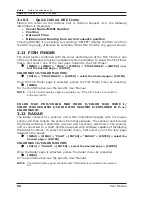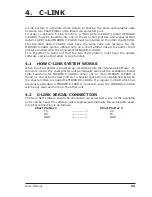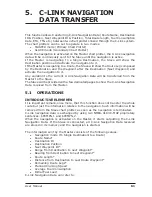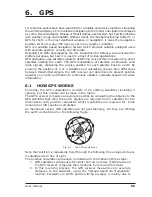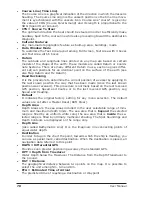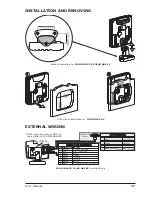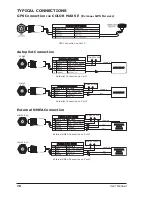
65
User Manual
6. GPS
For centuries, sailors have been searching for a reliable and precise method of travelling
the world's waterways. From celestial navigating to the modern navigation techniques
as Loran, Decca Navigator, Omega or Transit Satnav, each system has had its problems
with weather, range and reliability. Without doubt, the
"Global Positioning System",
or
GPS for short, is the most significant advance in navigation: it gives the navigator a
position 24 hours a day, 365 days a year in any weather condition.
GPS is a satellite based navigation system which provides suitably equipped users
with accurate position, velocity and time data.
Originally the GPS, developed by the U.S. Department of Defense, was conceived for
military purposes, but now it is used in a host of civilian applications.
GPS navigation uses satellite signals to determine your position in relation to a set of
satellites orbiting the earth. The GPS constellation of satellites continuously send
radio signals, containing the precise position for each satellite back to earth. By
knowing the position of 3 or 4 satellites and calculating various time differences
between transmitted signals, the GPS receiver can determine its present position
anywhere on earth, and thanks to continuous updates, calculate speed and course
information.
6.1
HOW GPS WORKS
Currently, the GPS constellation consists of 26 orbiting satellites (including 3
spares), but this number will increase in the future.
The GPS receiver computes an accurate position by calculating the distance to the
GPS satellites that orbit the earth. Signals are required from 3 satellites for two
dimensional (2D) position calculation whilst 4 satellites are required for three
dimensional (3D) position calculation.
As mentioned earlier, GPS satellites are not geostationary, but they are orbiting
the earth as illustrated on the following figure:
16
13
11
14
9
7
2
4
18
19
20
17
3
8
6
1
10
5
15
21
Fig. 6.1 - The GPS constellation
Note that position is repeatedly fixed through the following three steps while any
3 satellites are in line of sight.
The position calculation procedure is indicated in the following three steps:
1. GPS satellites continuously transmit their own precise orbital data and
the GPS receiver computes their locations by receiving this data.
2. In this receiving process, the GPS receiver measures very accurate
distances to the satellites, using the "Spread Spectrum Modulation"
method. Excellence in GPS's position-fixing accuracy is mainly due to
Summary of Contents for COLOR MAX 15
Page 20: ...22 User Manual...
Page 56: ...58 User Manual...
Page 58: ...60 User Manual...
Page 78: ...80 User Manual...
Page 84: ...86 User Manual...
Page 96: ...98 User Manual...






